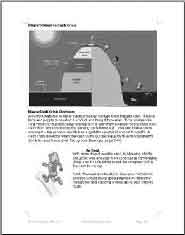 Don’t
Try this at Home Don’t
Try this at Home
"Rumor has it that if you put a frog in a pan of cold
water on the stove and turn on the heat, it will stay put
while the water gradually heats to a boil. At this point,
the frog becomes a tasty form of hot, green slime."
"Why doesn’t the frog jump out of the pan when it figures
out that the water is getting progressively warmer? There
are at least two reasons – denial and inertia. The frog initially
goes into a state of denial convincing itself that the water
is still cool. Then it goes into a state of inertia -- ‘well
the water does seem to be getting a little warmer and I probably
should take some action but I’m busy right now – I’ll deal
with that problem later.’
 Faced
with a looming cash crisis, the frog’s distant cousin – the
corporate executive -- often exhibits the same behavior. In
a bizarre quirk of nature, human beings (and frogs) often
go into a state of denial when faced with unpleasant news
– they choose to hide from the truth. I can’t figure out why
natural selection has allowed this characteristic to endure
throughout the ages. Unfortunately, in business this state
of denial, combined with inertia – a resistance to any form
of change or fluctuation in status quo -- often leads management
to delay taking evasive action until it’s too late. Faced
with a looming cash crisis, the frog’s distant cousin – the
corporate executive -- often exhibits the same behavior. In
a bizarre quirk of nature, human beings (and frogs) often
go into a state of denial when faced with unpleasant news
– they choose to hide from the truth. I can’t figure out why
natural selection has allowed this characteristic to endure
throughout the ages. Unfortunately, in business this state
of denial, combined with inertia – a resistance to any form
of change or fluctuation in status quo -- often leads management
to delay taking evasive action until it’s too late.
An unfortunate fact of life is that technology
startups burn through cash. It takes time and people to develop
a product and bring it to market. Time and people cost money
and a technology startup is in a seemingly endless race to
raise new cash from investors before the existing cash burns
out. You don’t raise funds overnight – the process usually
has a gestation period of around..”
A cash crisis develops when the cash burns
out more quickly than management’s ability to raise funds.
You go through various zones as a distant cash crisis develops
into a terminal cash crisis and you head down the slippery
slope to shutdown. This chapter provides practical advice
to help you navigate through the scramble zone, the survival
zone and the shutdown zone.
Among other important issues, this
chapter covers each of the following topics in some detail:
- How a cash crisis develops
- What to do on detecting a looming or
distant cash crisis
- Reversing negative momentum and escaping
a death spiral
- Raising funds
- Cutting costs
- Slashing costs
- Reinventing the company
- Warm and cold restarts
- Implementing an orderly shutdown
- Bankruptcy
|

 Don’t
Try this at Home
Don’t
Try this at Home Faced
with a looming cash crisis, the frog’s distant cousin – the
corporate executive -- often exhibits the same behavior. In
a bizarre quirk of nature, human beings (and frogs) often
go into a state of denial when faced with unpleasant news
– they choose to hide from the truth. I can’t figure out why
natural selection has allowed this characteristic to endure
throughout the ages. Unfortunately, in business this state
of denial, combined with inertia – a resistance to any form
of change or fluctuation in status quo -- often leads management
to delay taking evasive action until it’s too late.
Faced
with a looming cash crisis, the frog’s distant cousin – the
corporate executive -- often exhibits the same behavior. In
a bizarre quirk of nature, human beings (and frogs) often
go into a state of denial when faced with unpleasant news
– they choose to hide from the truth. I can’t figure out why
natural selection has allowed this characteristic to endure
throughout the ages. Unfortunately, in business this state
of denial, combined with inertia – a resistance to any form
of change or fluctuation in status quo -- often leads management
to delay taking evasive action until it’s too late.